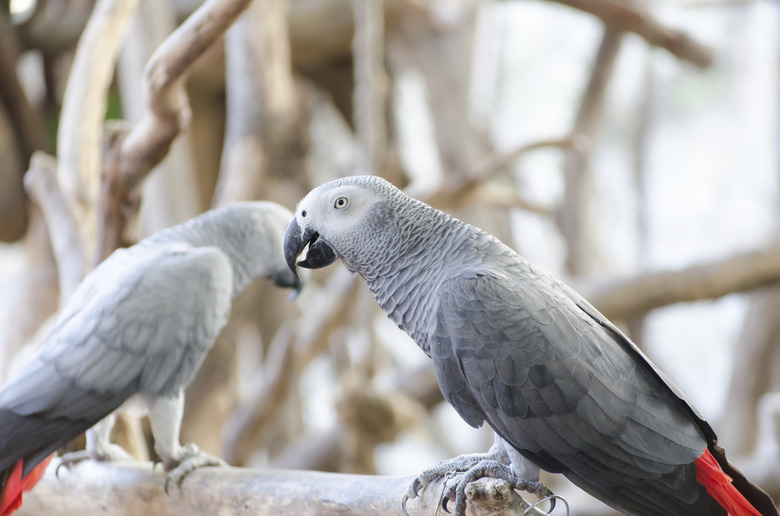How To Determine Gender Of African Grey Parrots
Today, wild populations of the African grey parrots are declining, making successful captive breeding programs more important to ensure the survival of this remarkably intelligent species. African grey males and females look nearly identical in this popular bird species, with subtle feather coloring being the only visual clue. It's important to confirm the sex of any bird that will become part of a breeding pair, which can only be done through scientific intervention.
Ruffle their feathers
Ruffle their feathers
Some owners and breeders of African greys say it's easy to discern the subtle differences between males and females once they reach an age of 18 months or more, or after their first molt. A male African grey's tail will remain solid red, while a female's red tail feathers become tipped with silver. The undersides of a male's wings become dark, while a female's remains light.
Other subtle differences between the male and female African grey include a more slender neck and narrower head in the female, and a rounded eye patch. The male eye patch becomes somewhat pointed behind the eye and males are usually bigger in size, about 12 to 14 inches in length.
Take a look inside
Take a look inside
For many years, using a surgical procedure for determining African grey male and female differences was the most common avian surgery performed by veterinarians. This method could confirm the sex of the parrot even before the first molt or sexual maturity.
The veterinarian makes a small incision on the parrot's left side, since this is where the female African grey's single ovary is located. A tube inserted through the muscle tissue provides a clear path for a small fiber-optic scope, which is used to view the bird's sex organs and other vital internal organs. Following confirmation of the bird's sex, a tattoo placed on the underside of the wing indicates the sex of the bird.
Prior to the procedure, the parrot gets a physical examination including its weight down to the gram to ensure the correct amount of anesthesia gets administered. The parrot must fast prior to the surgery to prevent unintended regurgitation during the procedure. The vet can also check the bird's other organs for any sign of disease or abnormalities during the surgery.
DNA analysis for birds
DNA analysis for birds
If you don't want to subject your bird to the stress of surgery and you can't tell whether its male or female from its feathers, you could send a few feathers for DNA analysis. Today, scientific advances have made DNA sexing of African greys possible, with almost 100% accuracy using polymerase chain reaction technology to detect male and female chromosomes.
The test can be accomplished by clipping a toenail close to the quick to provide a few drops of blood and putting them onto a blood card to mail in for analysis. If you choose the feather method, five to eight feathers must be plucked from the chest using a tweezer. Blood feathers and molted feathers don't contain enough DNA for testing.
If you're squeamish about pulling feathers or clipping toenails — or feel your bird might not forgive you for such an offense — take your bird to the vet. You can make your own DNA test kit to send in by downloading the forms to fill out, complete instructions, and a DNA blood card.
Surgery to sex a bird
Surgery to sex a bird
Surgical sexing, while nearly 100% accurate, puts your bird through quite a medical ordeal. Errors in surgical sexing normally result from poor visual identification of the sex organs due to a cloudy air sac or an enlarged stomach. Risks are associated with any surgical procedure, but the most common complication of surgical sexing is the risk of hemorrhage.
Surgery comes with a much higher cost than DNA analysis and a substantial recuperation period. DNA sexing of African greys, nearly as accurate as surgical sexing, presents fewer risks. A plucked feather or clipped nail could potentially become infected, leading to skin cysts or malformed feathers. An improperly packaged blood sample, such as sealing it in plastic during warm months, could cause fungal or bacterial growth, rendering the sample unusable.
